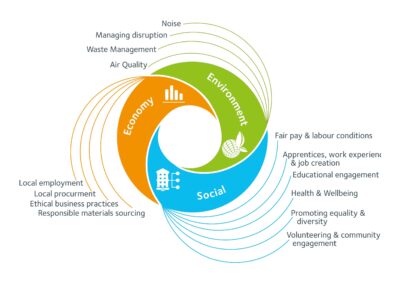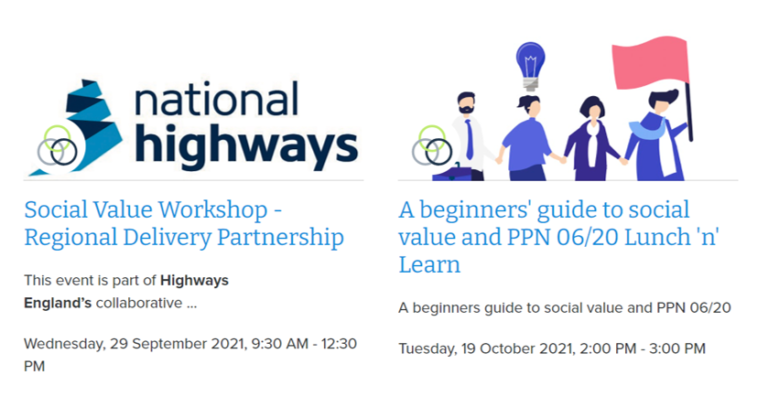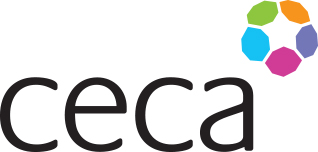What Is Social Value?
Social Value became more relevant to stakeholders after the Public Services Act 2012 was introduced. The act is defined as “An Act to require public authorities to have regard to economic, social and environmental well-being in connection with public services contracts; and for connected purposes”.
It is the amount of impact a public authority brings to society and the community in which they operate in economically, socially, and environmentally. These factors are known as the three pillars of sustainability.
The economy factor can relate to employment within the local community, purchasing from local suppliers and both sourcing materials/undergoing business practices within an ethical manner.
Social factors include equal pay and labour conditions, advocating equality and diversity, health and wellbeing, volunteering and community engagement, educational engagement and job creation, as well as apprentices and work experience.
Finally, there are also multiple environmental factors such as the air quality, managing disruption, waste management and noise pollution.

Social value can be presented in various ways. Brighton & Hove City Council chose to address social value in a guide for all of their council officers, service commissioners, bidders and suppliers.
Gloucester City Council’s answer to social value is providing a detailed toolkit for their residents and communities.
Social Value UK is an organisation that operate with the purpose for educating people that values are not only financial but coincide with the three pillars of sustainability. Since formed in 2007, they have had the vision of “A world where organisations are accountable for their impact on people and where decisions are made to improve wellbeing, equality and the environment for everyone.”
How Is It Measured?
Social Return on Investment (SROI) is a great method to use for measuring values, as it also accounts for values that are usually not shown within a financial statement. This is beneficial for social value, as you can also assess the social, environmental, and economical changes being developed to the community through the activities. When measuring SROI you should always consider the inputs, outputs, outcomes, and impact.
Inputs are things that are done to execute a project or activity. This can include the number of staff working on an activity, or the amount of finance used to put the activity in motion.
Outputs are direct findings connected with the activity. It is essentially the product of the activity (usually tangible).
Outcomes relates to how the activity has benefited the community (or any other intended parties), after implementing inputs and analysing outputs.
Finally, impact relates to what has changed as a whole. It takes note of how the activity has positively and negatively affected society and the companies resources/finances, as well as just the group it was intended for.
Another method of measuring social value is a Cost-Benefit Analysis (CBA). Similar to Social Return on Investment, it applies a monetary value to impacts from an activity.
Just as the name suggests, it’s an analysis of the costs that a certain project or activity may bring for those executing it. This can include a large number of things such as the cost of training for employees, the cost of new materials or the cost of renting a venue where the activity will be taking place.
Additionally, the possible benefits in the future are also considered within the analysis and are seen as monetary values. This aspect of the analysis is more complicated to analyse than the costs as it can be very unpredictable. When a company leads a new activity, it’s easy for them to add up the costs of materials, labour, etc. However, there is no way to determine if the activity will definitely bring benefits and what types they may be.
When performing a Cost Benefit Analysis there are two main equations. To calculate the net benefit, you simply minus the costs from the predicted benefits. To calculate the benefit cost ratio, you divide the benefits by costs.
Another method of measuring social value, is The Social Value Measurement Framework (National TOMs).
This framework was launched in 2017 by Social Value Portal and although the Public Services Act 2012 relates to public authorities, National TOMs (Themes, Measurements & Outcomes) also opens their framework to companies/organisations operating within the private sector.
How Can You Get Involved?
Want to get involved with social value? First, it’s important to educate yourself more on social value before starting to develop your company’s own response to social value, whether that be via a statement or toolkit.
Supply Chain Suitability School offer two 30-minute e-learning courses on social value, at an intermediate level. Each course ends with a 10-question test (multiple choice) to assess how much knowledge you have gained. A certificate of completion will also be available to you, provided you have passed with 80% or more.
Part one is centralised on what defines social value and focuses on why clients are insisting on it. Part two further builds on this knowledge, by informing you how social value can be produced, examined, and measured. By the end of this course, you will not only know the meaning of social value but will understand why it holds such an importance to both clients and contractors.
For those who are new to social value, a short 1-hour beginners course to “Introduction to Economy and Community” is also available to you.
Events & Training
Supply Chain Suitability School also have a Social Value Workshop taking place on September 29th from 9:30am to 12:30pm. This 90-minute course is perfect for beginners and will be taking place online via their website. There are only a limited number of spaces left so if interested then get in touch as soon as possible. Any queries about this workshop can be sent here.
A Lunch ‘n’ Learn will also be delivered through Supply Chain Suitability School on October 19th from 2pm to 3pm for beginners. As well as introducing attendees to social value, there will also be a breakdown of the Public Procurement Notice 06/20 (PPN 06/20).


